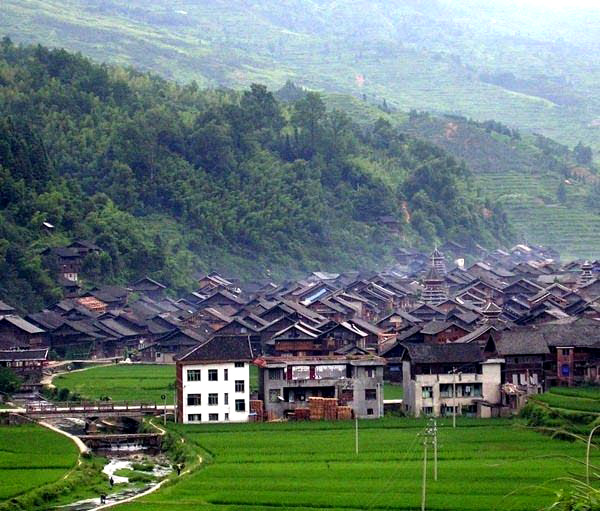 Guizhou Tour Guide
Guizhou Tour Guide Guizhou Hotels
Guizhou HotelsThe Housing Environment of the Dong People
Dong villages are traditionally built near rivers, in the fields, or at the foot of mountains. Distinct features of many Dong villages include a giant drum tower in the middle of the village, tall ancient trees scattered around, and a roofed wooden bridge across the local river. Because they are set in the countryside with minimal destruction of nature, the surrounding is exquisite.
The Dong lodgings are primarily wooden. Throughout Sanshu, Tianzhu, and Jinping counties, most of their homes are single-story, with one entrance. This door opens to the central room, in front of which an ancestors' memorial tablet is set. The rooms on the left and right are bedrooms. One of these will contain a fire-pit, which is used for cooking or keeping warm during the winter. The top floor is used for storing grain, piling up tools, and other odds and ends. In Liping, Congjiang, Rongjiang, and some areas of Jinping, most people build larger two to three story abodes, which normally face a river or field.
 |
 |
| Visit Zhaoxing, one of the largest Dong villages in China to fully experience the Dong people's lifestyle. | Fir-tree shaped drum tower standing in the middle of the village. |
The drum tower is the single most distinctive symbol of the village as well as the popular spot for community gatherings. During festivals, the drum tower is also a place for recreation. In the past, if there was a fire, robbery, or battle, the clan chief would send a person to climb up the tower to beat the drum, calling the villagers to action. Although this purpose has faded in recent years, the village drum tower is still an integral part of everyday village life, helping to maintain unity and group identity.
It is normal practice for each family clan to build a drum tower. So in some villages where there are several clans, as many as four to five towers are built. It is said that an American satellite took some pictures of these structures and mistook them as secret launching stations for China's nuclear weapons. These buildings are shaped like pagodas and made from fir trees. Their base is a square shape and the top is multi-angular. The tallest drum tower has seventeen floors and is over 20 meters (65 feet) high. Amazingly, these towers are built without a single nail or rivet. Many stand almost unaffected by centuries of erosion, wind, and rain.
The Dong's roofed wooden bridge is another treasure of China's national architectural art. It is built over a river or a stream far from the village. On the bridge there is a long covered corridor. In fact, these bridges combine pavilion, corridors, and bridge to provide a rest for weary travelers or protection from sudden storms.
Select Other Favorite Attractions
| Recommended China Tours with Guizhou | ||||||
|
||||||
|
||||||
Guide for China tour, offers most value & amazing experience. In China, you can rely on us
Copyright © 2001 - 2025. All Rights Reserved to ChinaTourGuide.Com
Hotel Guangzhou | Guizhou Tours | Hong Kong Hotels | 香港酒店 | 广州酒店 | 广州会议酒店 | Indochina Tour
Guide for China tours, offers most value & amazing experience. Chinatourguide.com. Your reliable China tour agency.



